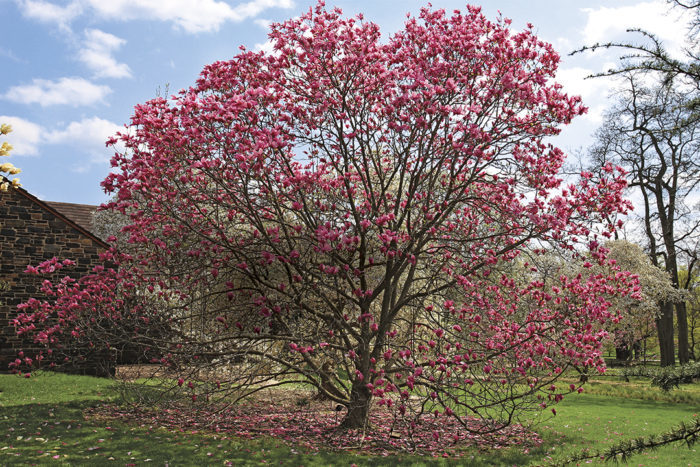
Magnolias (Magnolia spp. and cvs., USDA Hardiness Zones 3–9) have been appreciated as garden subjects for centuries. The Chinese planted magnolias at their temples as early as the seventh century, and magnolias featured prominently in Chinese and Japanese art. It is interesting to note that the first recorded magnolia to arrive in Europe was the U.S. native, sweetbay magnolia (Magnolia virginiana, Zones 6–9). With a diverse array of flower colors and forms, a range of sizes, and durability, it is worth finding room in all but the smallest garden for at least one.
Magnolias are not fussy in their needs, though the evergreen forms typically prefer to be out of cold, dessicating winds. Moist, well-drained soil is best, and because they will be long-term garden residents, it is well worth amending the planting bed with compost. Magnolias have fleshy roots that prefer not to be disturbed, especially during the growing season. Plant them while dormant, and avoid root disturbance. Underplant with long-lived perennials and small shrubs rather than with annuals.
Picking favorites among this venerable group is next to impossible, and an informal query among other magnolia lovers produced no consensus for the best of the best. As a southern gardener, I am able to grow almost any of this temperate species. However, my top picks include many that perform equally well in the frozen North.
‘Spectrum’ grows quickly and flowers young
Magnolia ‘Spectrum’
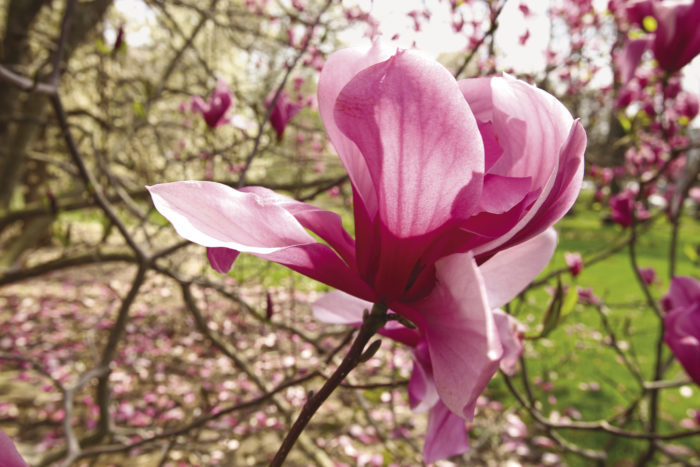
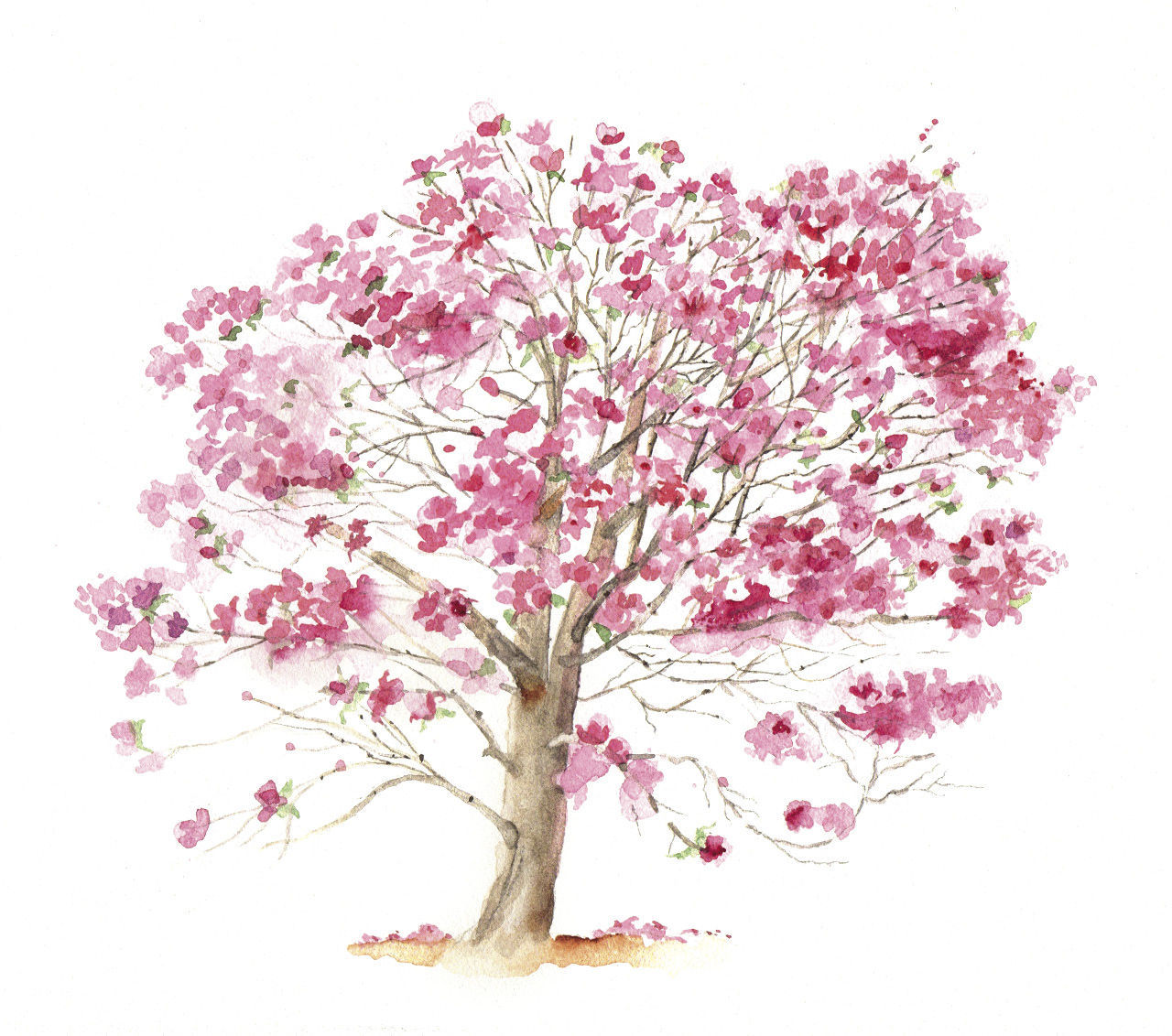
This large deciduous magnolia bears masses of brilliant, fragrant flowers in midspring. ‘Spectrum’, bred at the National Arboretum in 1962 by W. F. Kosar, is large enough to serve as a shade tree in a smaller suburban landscape but open enough to allow shade perennials and shrubs to thrive beneath it. The individual, upright flowers easily can be 10 to 12 inches wide, and a tree in full flower is truly a sight to behold.
‘Spectrum’ has stout branches, which can be lovely in the winter against a crisp, clear blue sky. It is a quick grower and has been used extensively as a rootstock for grafted magnolias, since the vigorous root system will encourage quick growth. It flowers at a young age, and plants as young as 3 to 4 years old can put on an impressive display.
USDA Hardiness Zones: 5–9
Height: 30 feet
Width: 15 to 30 feet
‘Lois’ has luminous mid-spring blooms
Magnolia ‘Lois’


This outstanding magnolia from the Brooklyn Botanic Garden’s breeding program has clear primrose yellow flowers with an enticing fragrance. It blooms in mid-spring, later than some other yellow forms, and thus avoids all but the latest frosts. The flowers remain yellow instead of fading to creamy white as some others do.
This tree can get relatively large with a broad, rounded outline. When grown as a specimen in an open spot, the blooms seem to collect all of the light, even on a cloudy day, and reflect a soft glow onto the landscape. If allowed to branch low and if underplanted with blue flowering perennials like lungwort (Pulmonaria spp. and cvs., Zones 2–8), which bloom at the same time, the resulting display can provide a near religious experience.
Zones: 4–9
Height: 25 feet
Width: 25 feet
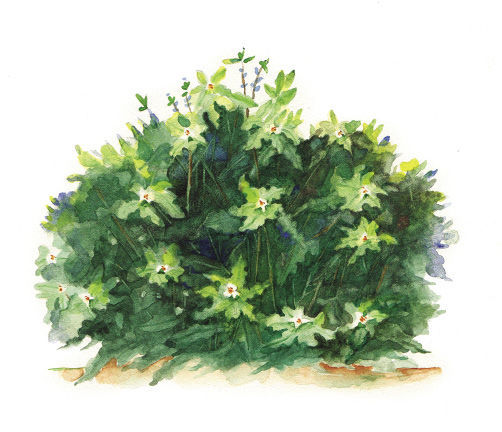
This magnolia occurs in the panhandle of Florida where it was pushed down from the Appalachian Mountains during the last ice age. Its former home in the uplands has left this Deep South species with a remarkable tolerance to cold, well beyond what would be expected. Its papery-textured, banana-like foliage grows up to 24 inches long and almost half as wide with a silvery-white underside. Huge flowers, up to a foot across, are typically tinted with purple at the base, resting atop whorls of foliage in late spring.
Unlike the other bigleaf magnolias, which are single-trunked, this species tends to grow with multiple stems like a large, rounded shrub. The lower growing form makes it easy to enjoy the floral display and the striking foliage, which gives the plant a tropical or prehistoric look. It will need some protection from afternoon sun in the South, but can tolerate more light in cooler areas. Grow in a moist but not waterlogged site out of high winds, which can shred the leaves.
Zones: 5–9
Height: 15 to 30 feet
Width: 15 to 30 feet
‘Coral Lake’ offers shimmering color for smaller gardens
Magnolia ‘Coral Lake’

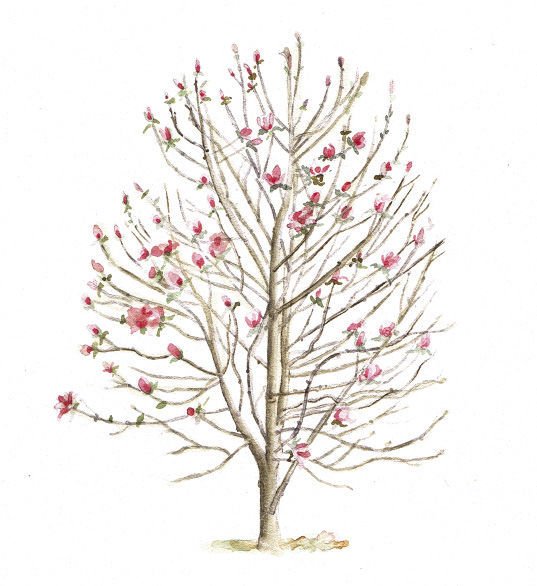
‘Coral Lake’ is a breakthrough in color for magnolias with large flowers in shades of pink with yellow tones streaking up the tepals. The interiors of the flowers are a similar mix of colors in lighter shades. The overall effect is shimmering coral, thick-textured flowers up to 7 inches across when fully open. The colors shift and change throughout the day as the sun strikes at different angles. In one light the flowers are heavily colored with yellow, but later they appear almost pink. As a bonus, the flowers don’t begin to open until just before the leaves emerge, making them immune to most late frosts.
‘Coral Lake’ is stout-branched and relatively compact, with a distinctly upright sweep to the branches—not so much fastigiate as gumdrop-shaped. After a decade of growth, it should be less than 25 feet tall and 12 feet wide, ideal for a smaller garden. ‘Coral Lake’ was hybridized by breeder David Leach, who crossed two larger yellow selections. When the seedling first flowered, he realized that some horticultural hanky-panky had happened, but concluded that sometimes Mother Nature does know best and introduced ‘Coral Lake’ to the world.
Zones: 5–9
Height: 18 to 25 feet
Width: 8 to 12 feet
‘Royal Robes’ is ideal for hedges and borders
Magnolia figo var. crassipes ‘Royal Robes’

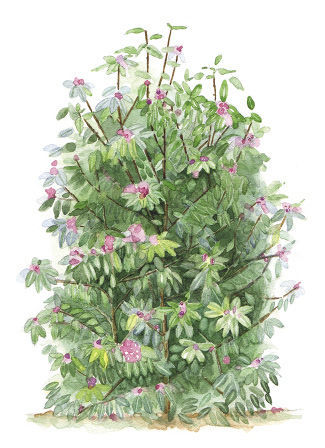
This evergreen magnolia has quickly become one of the most commented upon at the JC Raulston Arboretum, where it forms a tight, upright pyramid of dark, forest green foliage. In May, it covers itself in deep burgundy flowers with a fruity fragrance. The flowers are small, at just under 2 inches across, but this flowering machine bears the blooms from stem tip back along the previous year’s growth. It will flower sporadically through the summer season but not in any significant numbers after the spring show.
I have found ‘Royal Robes’ to be tough but moderately slow growing even in full sun and rich soil. It would be ideal as a hedge, in a mixed shrub border, or anchoring the corner of a foundation planting. The 10-year height in full sun will be 8 to 15 feet and about half as wide. In a shadier location, expect it to stretch and open up a bit more. It has proven to be cold-hardy, barely discoloring even in single digits for short periods. However, it should be sited out of cold, drying winter winds.
Zones: 7–10
Height: 8 to 15 feet
Width: 4 to 8 feet
‘Satellite’s’ leaves, fruit, and flowers are out of this world
Magnolia virginiana var. australis ‘Satellite’
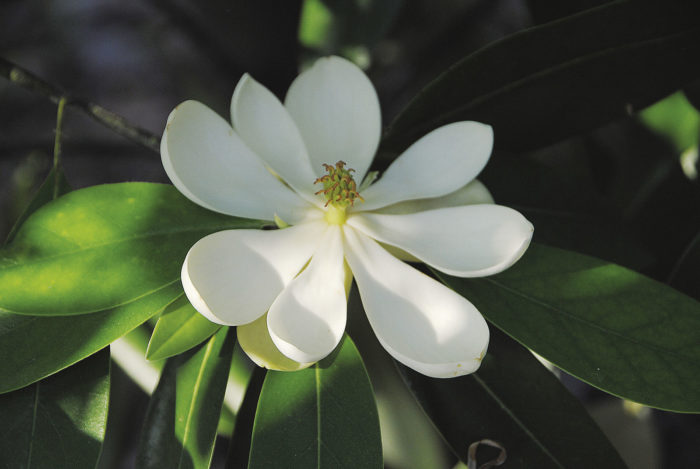
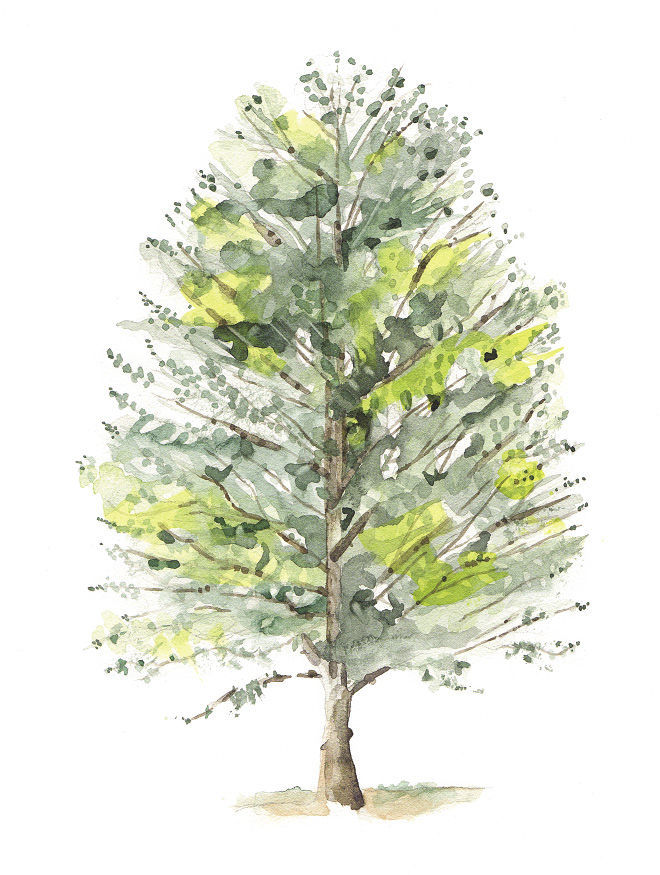
In 1968, at the height of the space craze, ‘Satellite’ was selected and named by the U.S. National Arboretum’s Frank Santamour. With well-spaced branching, attractive evergreen foliage and large flowers, it is still one of the best forms of the species available. Its deep green leaves have silvery-blue undersides. Lemon-scented, 3-inch flowers bloom from spring to early summer, followed by pinecone-like fruit that split open to reveal brilliant red seeds from summer to fall.
Sweetbay magnolia is native to the eastern United States. In the southern part of its range, M. virginiana var. australis is a tall, single-stemmed, evergreen tree. The northern form, M. virginiana, is shrubbier, multistemmed, and semi-deciduous. ‘Satellite’, a southern form, has proven to be surprisingly cold-hardy.
Zones: 5–10
Height: 20 to 30 feet
Width: 20 to 30 feet
‘Judy Zuk’ has a narrow, upright habit and golden blooms
Magnolia ‘Judy Zuk’


Named for the late director of the Brooklyn Botanic Garden where this exceptional magnolia was developed, ‘Judy Zuk’ has quickly gone from being a relative unknown selection to topping the lists of many magnoliaphiles. Andrew Bunting, former president of the Magnolia Society International, says this is his favorite—high praise indeed.
‘Judy Zuk’ may have the deepest gold color of any magnolia, verging on orange in some locations, with purple and pink staining at the base of the flower. The blossoms have a fruity fragrance which has been compared, favorably, I think, to Froot Loops cereal. The flowers emerge relatively late in spring, avoiding frost damage, and tend to stay upright and tight for an extended period.
Among its other remarkable attributes, ‘Judy Zuk’ has a narrow and upright habit, allowing it to fit in spaces many other deciduous magnolias would outgrow quickly.
Zones: 5–9
Height: 30 feet
Width: 8 to 12 feet
‘March til Frost’ reblooms throughout the season
Magnolia ‘March til Frost’
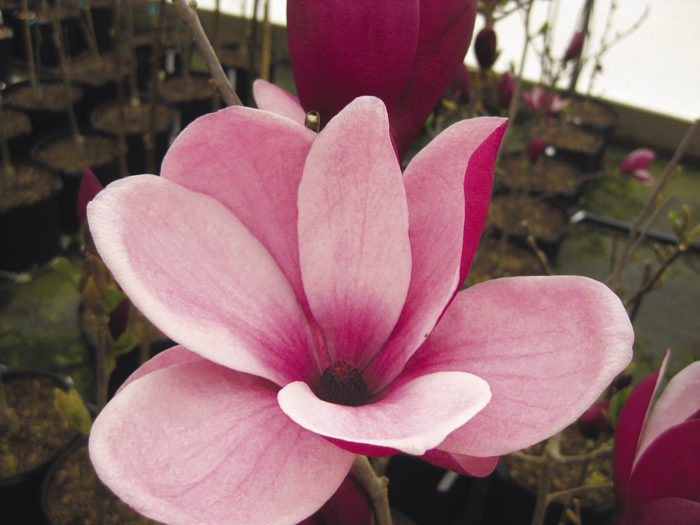
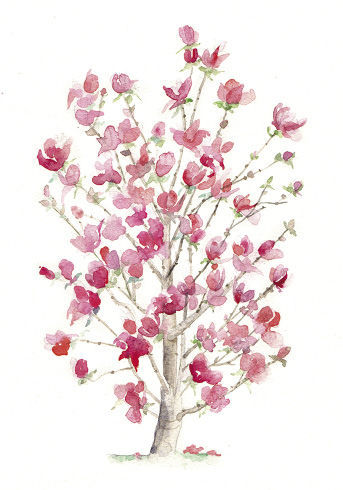
I had heard all the rumors but must confess that I did not believe the hype surrounding this deciduous magnolia until I tried it for myself. Large goblets of rosy-purple flowers with pale interiors open en masse in spring and then continue sporadically throughout the growing season. Prolific magnolia breeder Dr. August Kehr considered this one of his finest introductions, and I agree.
‘March til Frost’ makes a striking addition to a woodland edge, a border, or as a specimen plant where the summer and fall flowers add season-long interest. It is a heavy feeder and will benefit from a midsummer shot of your favorite fertilizer or a spring application of a slow-release fertilizer. Top-dress with compost in winter.
Zones: 5–9
Height: 15 to 20 feet
Width: 12 to 18 feet
Teddy Bear® has exceptional form and foliage
Magnolia grandiflora ‘Southern Charm’
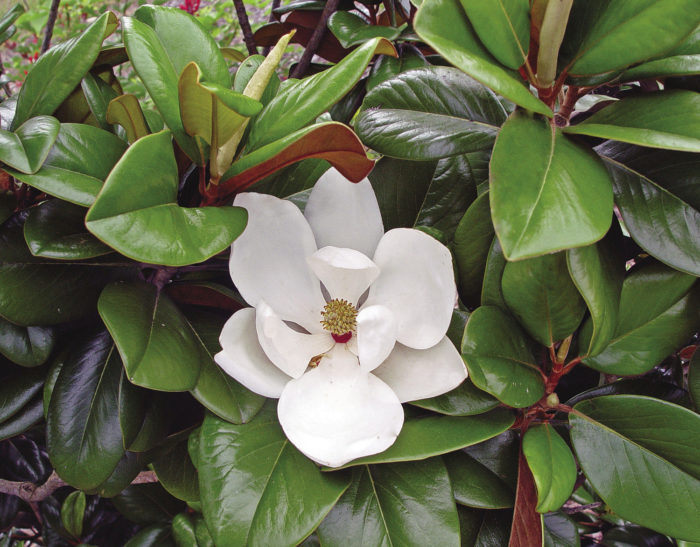
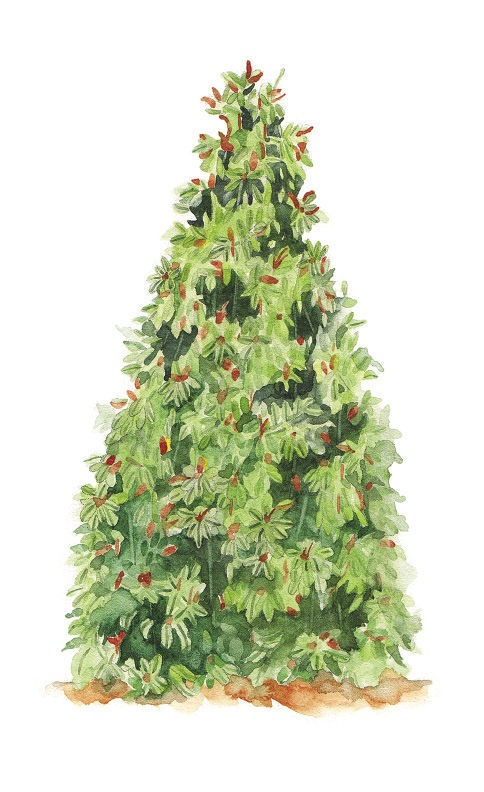
This outstanding selection of southern magnolia from Bob Head of South Carolina is my top pick for modern landscapes. While larger selections are fine for antebellum mansions, most of us are somewhat more restricted regarding space. ‘Southern Charm’ is a slow-growing, exceptionally dense evergreen tree. The broad, leathery leaves are deep green above and heavily felted with rusty brown hairs beneath. Large, white, lemon-scented flowers grace the tree in late spring and off and on throughout the summer. The exceptional form and foliage more than make up for the somewhat shy floral display.
The original seedling hasn’t topped 30 feet after 30 years in the garden, and has a very upright pyramidal habit. Teddy Bear® is a better plant for small gardens than the popular ‘Little Gem’ (M. grandiflora ‘Little Gem’, Zones 7–9), remaining more compact and much denser. Plant it as a specimen, hedge, or allee, where the form can be appreciated.
Zones: 7–9
Height: 30 feet
Width: 15 feet
‘Chrysanthemumiflora’ has finely textured blooms and branches
Magnolia stellata ‘Chrysanthemumiflora’
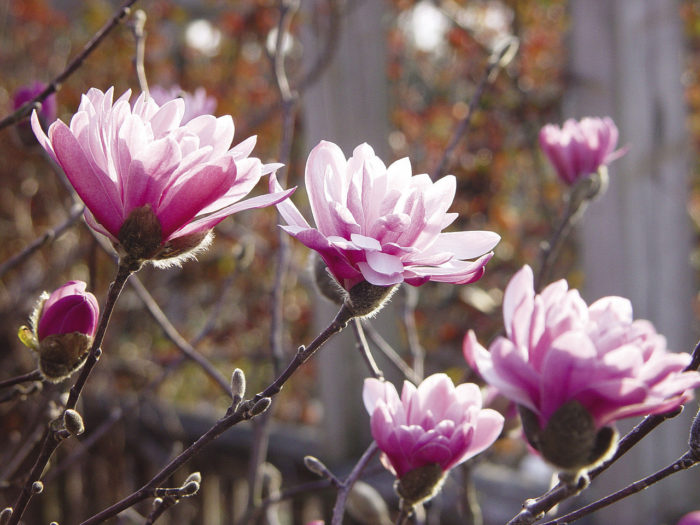
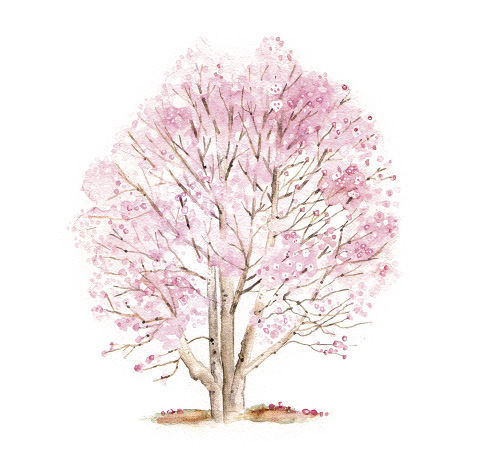
This strikingly beautiful star magnolia comes from famed Japanese breeder K. Wada, who introduced many outstanding magnolias to cultivation. ‘Chrysanthemumiflora’ is often considered the finest pink star magnolia, with up to 40 tepals on each softly blushed flower. Small leaves and twiggy growth give it a relatively fine texture throughout the growing season.
This, like many other star magnolias, can be grown as a large, low-branched shrub or trained up to a single-stemmed small tree. While it blooms early enough in spring to be hit by the occasional late frost, it more typically puts on a reliable show. It makes a spectacular specimen and is best planted where the flowers can be viewed up close.
Zones: 4–8
Height: 12 to 18 feet
Width: 8 to 12 feet
Growing Magnolias
Magnolias are easy to care for and long-lived if sited in full sun to light shade in moist, organic, well-drained soil.

Selection
Choose a plant that is not root-bound. A healthy root system is more important than a tall trunk.
If your magnolia is grafted, look for a healthy union where the top meets the root system. Avoid “doglegs” (a severe angle at the union), and avoid plants with multiple suckers below the graft.
Care
Amend the planting bed with compost if necessary.
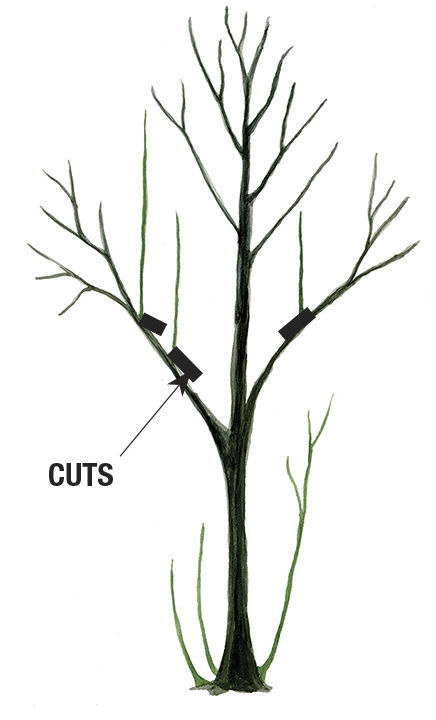
Water regularly during the first two to three years, and during periods of drought.
It is important to time pruning correctly. Most spring flowering types can be pruned after they bloom; trim summer flowering species in winter. Magnolias need little pruning to thrive if they are sited correctly.
Water sprouts (vigorous shoots that grow straight up from horizontal stems) can be pruned out during the winter, as can crossing branches and any shoots emerging from below the graft. Otherwise, let the magnolia grow naturally with only an occasional snip for shaping.
Pests

Magnolia scale (Neolecanium cornuparvum), pictured, has a shiny brown shell up to ½ inch in diameter, often covered with white, fuzzy wax. Adults attach themselves to branches, sucking fluids from the plant and excreting sticky honeydew. If you notice only a few scale insects, remove them by hand. For larger infestations, spray with dormant oil in early spring as the young, mobile “crawlers” emerge.
Deciduous magnolias are not damaged often by deer, though flower buds may be eaten. Evergreen varieties, with the exception of southern magnolia (M. grandiflora, Zones 7–9), may need protection from browsing deer when young. Antler rubbing damages the thin bark of young magnolias, and may kill or permanently disfigure a tree.
To discourage voles and other rodents from chewing roots or bark around a tree’s base, avoid piling mulch against the trunk.
Mark Weathington is director and curator of collections at the JC Raulston Arboretum at NC State University in Raleigh, North Carolina.
Photos: Carol Collins. Illustrations: Grace McEnaney; millettephotomedia.com; courtesy of William M. Fountain/University of Kentucky/bugwood.org; courtesy of JC Raulston Arboretum at NC State University; courtesy of Pleasant Run Nursery; courtesy of Garden Debut®
Sources
- Broken Arrow Nursery, Hamden, CT; 203-288-1026; brokenarrownursery.com
- Nurseries Caroliniana, North Augusta, NC; 803-279-2707; nurcar.com
- Rare Find Nursery, Jackson, NJ; 732-833-0613; rarefindnursery.com


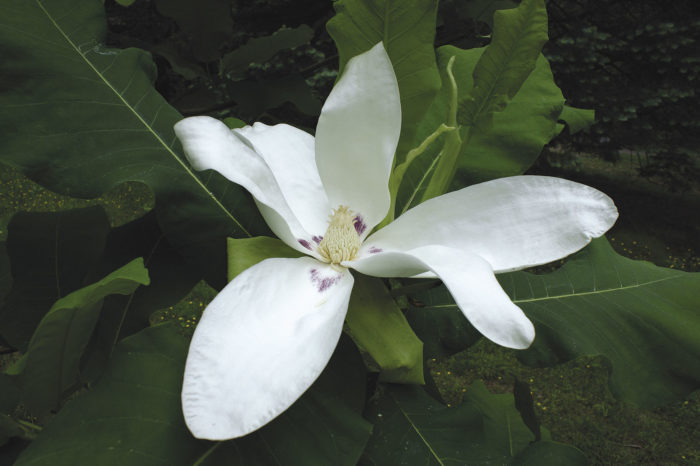
















Comments
Log in or create an account to post a comment.
Sign up Log in